Picture this. A cloudless day of a pleasant 69 degrees with
3 mile an hour winds gently wafting across the land from the south.
With the exception of the riffles, the water has the appearance of
glass, natures mirror, to reflect to deep azure skies and confuse
the senses. It's midday and the sun feels much warmer than the
posted temperature. The trees are bare with the skeletal look
brought upon them by demands of winter. The few evergreens to
remind us of the promise of renew in the not to distant approaching
spring. In the creek, deeper pools of smooth reflective surface broken
by the occasional "vee" trails of fish on an unknown errands. A
lone fly fisher peering through the brush into waters so clear that
individual rocks on the bottom could be counted. The bream and bass
are schooling in the shallows where the radiance of the sun has warmed
the waters, continuing the cycle of life. Nymphs are on the move and
some are rising for the hatch. The fish are feeding, not quite surface
feeding but close enough to cause many surface swells and rings. A
visual key to the fly fisher of potential catches.

Kneeling behind the bush, the fly fisher picks through his collection
of nymphs, choosing one of a new pattern. Though never tried before,
he hopes for success. With high hopes and great expectations he ties
on the nymph, adds the correct amount of weight and prepares for the
cast. He cannot stand, for the fish will see him and flee into the
deeper waters. Most likely not to be seen again for several minutes,
only to return even more on guard than before. This requires casting
with stealth. He kneels behind the bush and with his non-casting hand,
slowly places his rod tip out towards the water without the reflection
or shadow falling over the feeding fish all the while feeding line out
while holding the nymph in his casting hand. Like an archer the fly
fisher pulls the nymph back putting a nice bend in the rod. Upon
releasing the nymph, it sails out over the water and floats down
to the surface and slowly sinks towards the bottom. As the fly
fisher watches, a shape darts in and takes the nymph. The fly
fisher sets the hook and like a torpedo, the panicked fish heads
for the safety of deeper water. The fly fisher plays the fish and
brings in a beautiful yellow breasted bream with the bright blue
markings on it's gill covers. After admiring the fish, it is gently
released. The fly fisher sits behind his bush and waits for the next
opportunity to catch another prize bream. For the fly fisher, this is
a game of patience and skill with beautiful rewards.
 True story? Yes, that was me a few days ago. I had tied a new nymph
and was in a hurry to try it out. When I walked down to the creek
there was a lot of activity, but unfortunately I got too close and
the fish scattered. So the above scenario took place. The method
used is called the "bow shot" or "bow and arrow cast." You hear
about the bow shot here and there, usually with indifference, but
depending on the area you are fishing it could mean the difference
between a day of frustration or a day of great fishing.
True story? Yes, that was me a few days ago. I had tied a new nymph
and was in a hurry to try it out. When I walked down to the creek
there was a lot of activity, but unfortunately I got too close and
the fish scattered. So the above scenario took place. The method
used is called the "bow shot" or "bow and arrow cast." You hear
about the bow shot here and there, usually with indifference, but
depending on the area you are fishing it could mean the difference
between a day of frustration or a day of great fishing.
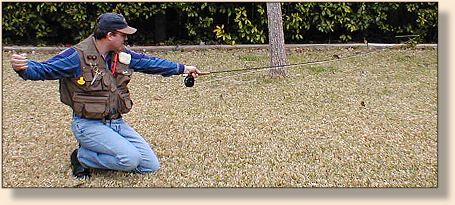
I have had to depend on it on many occasions. There are some places
on the local creeks here that between the trees and overhangs, the
only way to get a fly in the pocket, is to use the bow shot. I have
had to get in under the drooping branches of large willow trees,
kneel down and bow shoot the fly in under the overhanging bank where
the bull Gill's were. Roll casting, steeple casting and other various
methods will simply not work in these instances. Learning the bow
shot and practicing it until you get the desired distance and placement
can be extremely rewarding. It also means not having to give up
those promising looking holes which seem impossible to fish and
without scaring the fish off.
The new nymph? It was very much a success! This is another
non-traditional material fly that I created and has proven to
attract fish. I call this one the Pompom Nymph (PPN). It's
simple, quick and material only consists of four items. Streamside
tying is a snap! Also variations in color and style are simply
unlimited. The nymph will float until the pompoms are saturated
with water so be sure to soak it prior to casting or add weight
to the line. I prefer sink putty as it's non-toxic, bio-degradable
and can be fine tuned for achieving neutral buoyancy with various flys.
By the way, look at the fish photos again, the nymph is the one
featured in this article. Good luck!
Materials:
Hook: Orvis 11HL size 2X, 12.
Thread: Black 6/0.
Head: 5mm brown pom pom.
Body: 3mm brown pom pom.
Legs: Flashabou Accent.
Tail: Flashabou Accent.
Tying Instructions:
NOTE: For a cleaner appearance and a more natural look, be sure the
pom poms are centered on the hook.
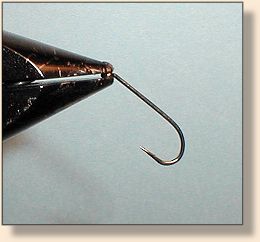
1. Place the eye of the hook in the tying vice. Lay a single layer
of thread beginning at the bend of the hook and ending with a whip
finish at the eye.
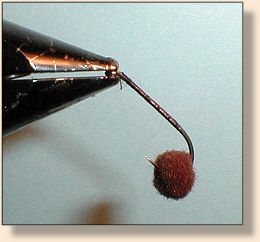
2. Start the 5mm pom pom which will be the head.
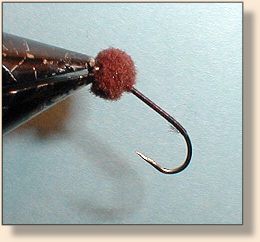
3. Place a small drop of zap-a-gap just behind the eye and push
the pom pom up to the eye.

4. Tie in the Marabou Accent just behind the head. Remove extra thread.
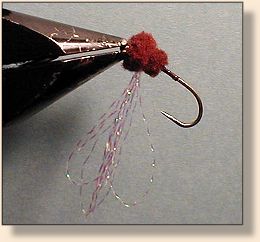
5. Place 3mm pom pom on the hook, slide up just behind the legs.
Add a small drop of Zap-a-Gap over the legs and push the second
pom pom up as close to the first pom pom as you can. There should
not be a noticeable gap.
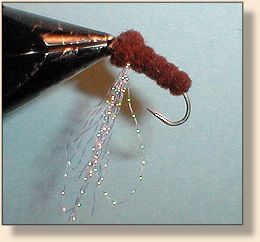
6. Repeat step 5 adding the next 3mm pom poms until there are four
3mm pom poms on the hook.
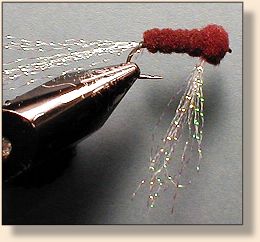
7. Reverse the hook in the vice and tie in the tail using the Marabou Accent.
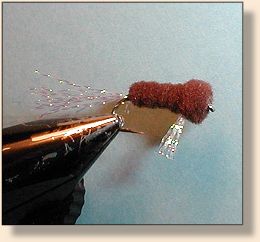
8. Trim tail and legs to desired length. ~ Johnny (Hillfisher)
|

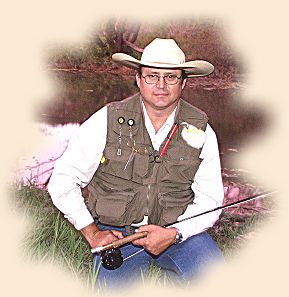


 True story? Yes, that was me a few days ago. I had tied a new nymph
and was in a hurry to try it out. When I walked down to the creek
there was a lot of activity, but unfortunately I got too close and
the fish scattered. So the above scenario took place. The method
used is called the "bow shot" or "bow and arrow cast." You hear
about the bow shot here and there, usually with indifference, but
depending on the area you are fishing it could mean the difference
between a day of frustration or a day of great fishing.
True story? Yes, that was me a few days ago. I had tied a new nymph
and was in a hurry to try it out. When I walked down to the creek
there was a lot of activity, but unfortunately I got too close and
the fish scattered. So the above scenario took place. The method
used is called the "bow shot" or "bow and arrow cast." You hear
about the bow shot here and there, usually with indifference, but
depending on the area you are fishing it could mean the difference
between a day of frustration or a day of great fishing.






